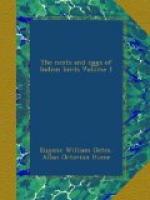the Sparrow alone of all known birds would have selected
it for a site; and even the Sparrow only under the
condition of a writing or toilet-table being underneath
to catch the lime, sticks, straws, rags, feathers,
and other innumerable materials that commonly strew
the ground below a Sparrow’s nest. I was
told that the Crows had been at their task for two
months before I saw them, and I then watched them
till nearly the end of October. The celebrated
spider that taught King Bruce a lesson in patience
was eager and fitful compared with this pair of Crows.
I kept no account of the number of times their structure
was blown down, only to be immediately begun again;
but as there was a good deal of rain and wind at that
season, in addition to the regular sea-breeze, it
was a common thing for the sticks to be cleared off
day after day. But perseverance will often achieve
seeming impossibilities, and, moreover, the Crows
worked more indefatigably as the season went on, and
used to run up their nest with great rapidity (no
doubt, also, they improved by their practice); so that
several times the structure was completed, or nearly
completed, before being swept to the ground, though
how it remained in its place for a moment seems a
mystery; and twice I saw a broken egg among the scattered
debris. At length, about the middle of
September, the Crows determined to try the pillar
at the other end of the verandah. By this time,
of course, all the Crows in Madras had long brought
up their broods and sent them adrift; and what they
thought to see an eccentric pair of their own species
forsaking society, and
building in September,
may be imagined. The new site selected differed
in no respect from the old one, and was no less exposed
to the wind; but the birds had grown expert at building
‘castles in the air,’ and now met with
fewer mishaps. In the first week of October the
hen bird was sitting regularly, so on the 8th of the
month I sent a man up by a ladder, and he held up
four eggs for me to look at. It fairly seemed
after this that patience was to have its reward, but
on the night of the 20th there came a storm of wind
and rain, and when I went to the office in the morning,
the nest was lying on the ground, with two young Crows
in it, with the feathers just beginning to appear.
The other two, I suppose, had fallen over into the
street. And thus ended one of the most persevering
attempts on record to overcome a difficulty insurmountable
from the first. The old birds thought it time
now to stop operations, and frequented the office no
more.
“I am told by a gentleman in the ‘Mail’
office that the Crows have built in that verandah
regularly for five or six years past, but nobody seems
to have watched the nests. I am, therefore, hopeful
that the attempt will be repeated this year, in which
case I will keep a diary of all that takes place.”
He writes subsequently:—“I sent you
a long story in my last batch of notes about two eccentric
Crows that succeeded in building a nest upon the narrow
ledge of a pillar in the verandah of my office, several
months after all well-conducted Crows had sent out
their progeny to battle with the world. I mentioned
to you that they were said to build in that unnatural
place every year, and I said that I would watch them
this year.




